What Types of Boats There Are
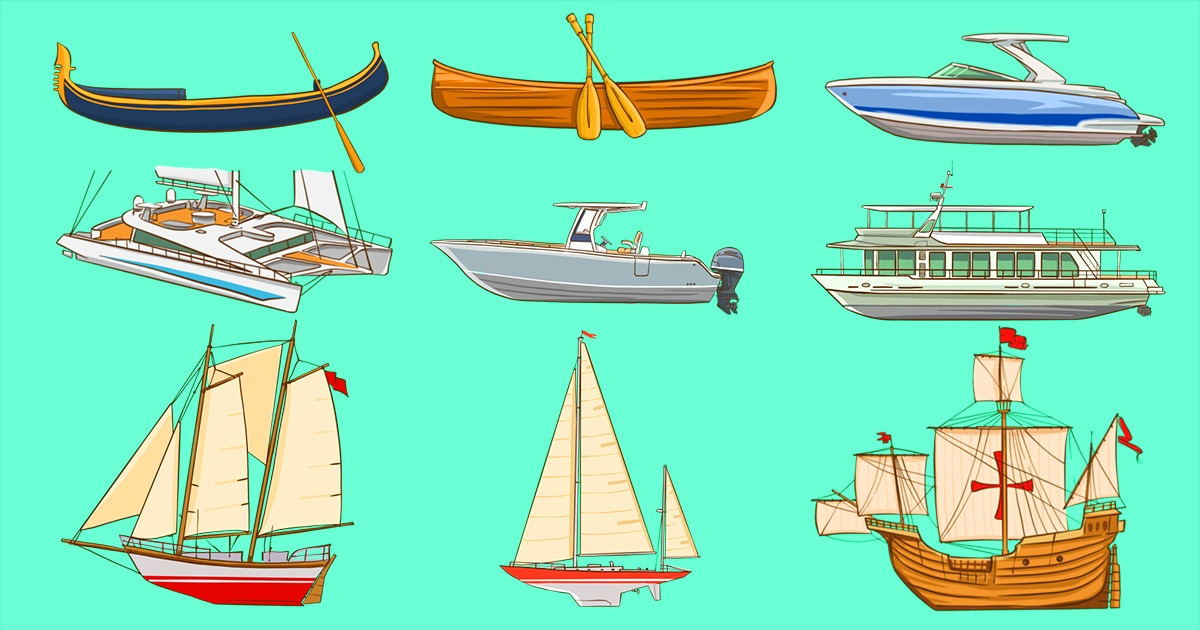
Many people know boats are supposed to be smaller in comparison to ships. They’re generally easier to sail with but have less carrying capacity as well. Officially, boats are made to navigate near-shore areas or inland waterways, such as rivers and lakes.
Throughout history, boats were built in many shapes and sizes and served great purposes, so it would be hard to name them all, but 5-Minute Crafts created a list of the most common ones.
Anatomy of the boat
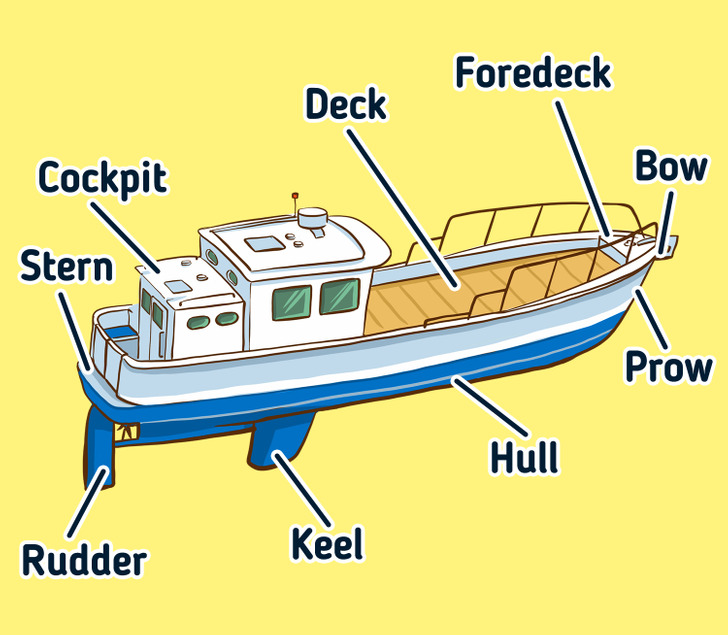
Before we move on to the classification, let’s take a look at a few important things, like the parts of a boat and terminology.
And these are:
- Hull: the body of the boat
- Bow: the front of the boat
- Stern: the back part of the boat
- Prow: the most up-front part of the boat that strokes through the water
- Keel: the backbone of a boat, a very important structural part
- Cockpit: a closed space on deck from which people can steer the boat
- Deck: the surface of a boat that is flat
- Foredeck: the deck at the forward part of a ship
- Rudder: the main control part that is used to steer a ship
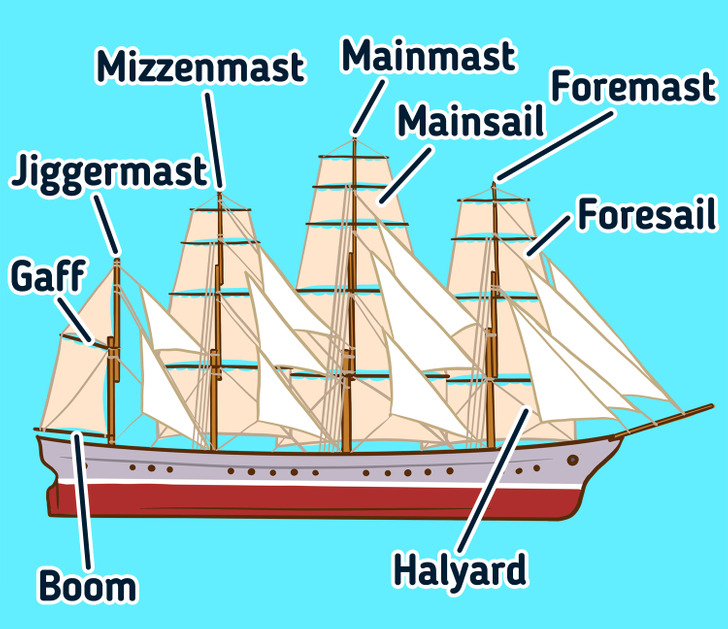
- Mast (main): a long pole that stands vertically and holds up the boat
- Mainsail: the sail that is put on the mainmast
- Foresail: one of the sails set on the foremast that comes after the mainsail (on the sloop sailboat, for instance)
- Headsail (jib): a sail set ahead of the foremast (the mast near to the bow, similar to the mainmast on the bigger boats)
- Mizzen mast: a shorter mast aft or next aft of the mainmast in a ship — can also be a shorter mast, like on the ketch or a yawl
- Spar (gaff): a pole that supports sailing
- Boom: a pole that can enhance the control of sailing
- Halyard: a rope or a tackle that sailors use for hoisting and lowering sails
- Jigger mast: the fourth mast, near the stern on a boat that has 4 or more masts
Note: Aft means near or in the stern of a ship.
1. Unpowered boats
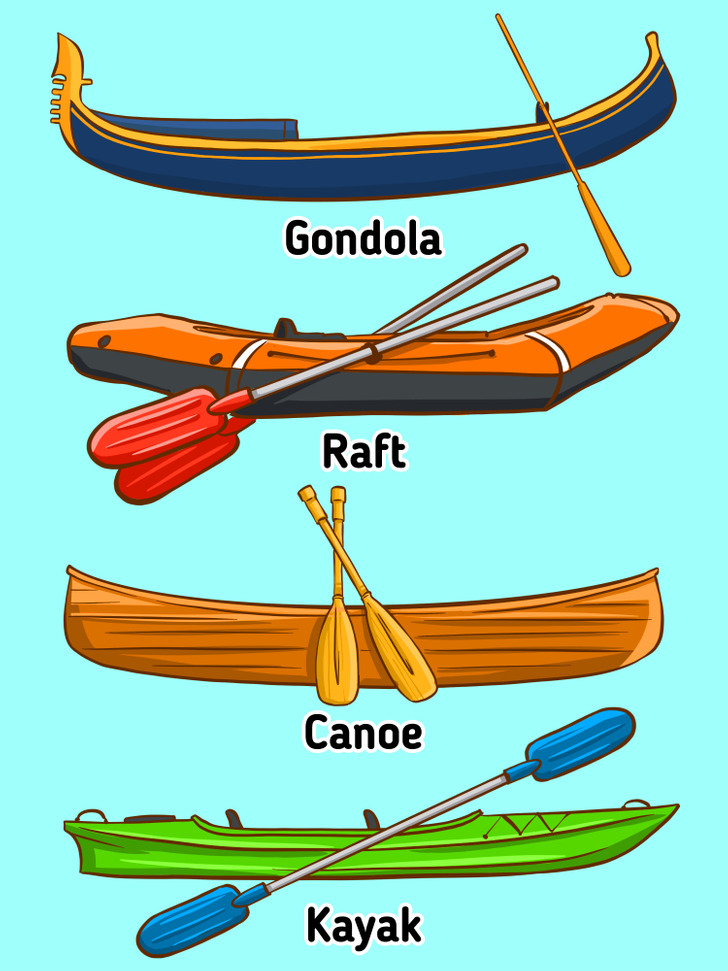
These boats are also called human-powered boats and are meant for one-way downstream travel.
These include:
- A gondola is a very long 32-foot (10-meter) flat-bottomed, tapered boat that is historically associated with the canals and lagoons of Venice. It can carry anywhere from 2 to 6 passengers and it is propelled by a gondolier, who uses an oar to row. Gondolas are very unique because of their asymmetrical shape and prominent steel beak (ferro) that rises from the prow, and a lesser-known one (risso), which rises from the stern.
- A raft is one of the simplest boats, usually made of logs or planks that are fastened together. Today, many people use the inflatable, recreational raft made of flexible materials to navigate downstream on river rapids while using paddles. This sport is commonly known as rafting.
Inflatable rafts can also be used as lifeboats on different boats and ships. - A canoe is a small, lightweight boat with both ends pointed up. It is propelled by paddles, and paddlers face the bow of the canoe.
- A kayak is actually a type of canoe and it also has a pointed bow and stern, but unlike the canoe, this boat is covered, except for a cockpit in which the paddler or paddlers sit. The paddlers face forward and use a double-bladed paddle. The first kayaks were built by Inuit and Aleut people from the Arctic region of North America.
2. Motorboats
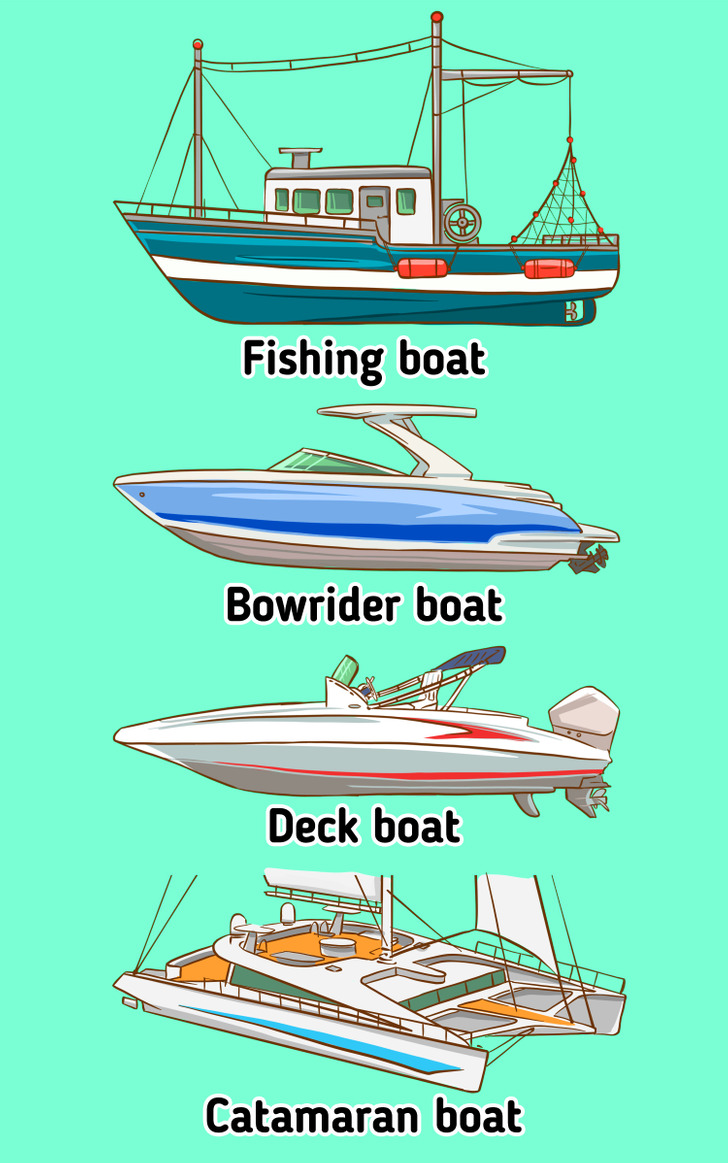
Motorboats or motorsailers are engine-powered and can move forward in the water.
These include:
- Fishing boats are built in different sizes and are used on both salt and freshwater bodies for fishing. They are very stable and strong and are equipped with fishing gear and instruments.
- Bowrider boats are known as family-friendly boats because people use them when going on family adventures, cruising, water skiing, and engaging in other water activities. An open bow area provides extra seating space for 8 or more passengers.
- Deck boats have a unique design, some deck space, and are fast. These boats are easy to operate and don’t need much maintenance. They can provide plenty of seats for a small group of people.
- Catamaran boats have 2 parallel hulls on both sides that balance the boat. It is used primarily for sailing but can also be used for fishing because they are built for various purposes across the world.
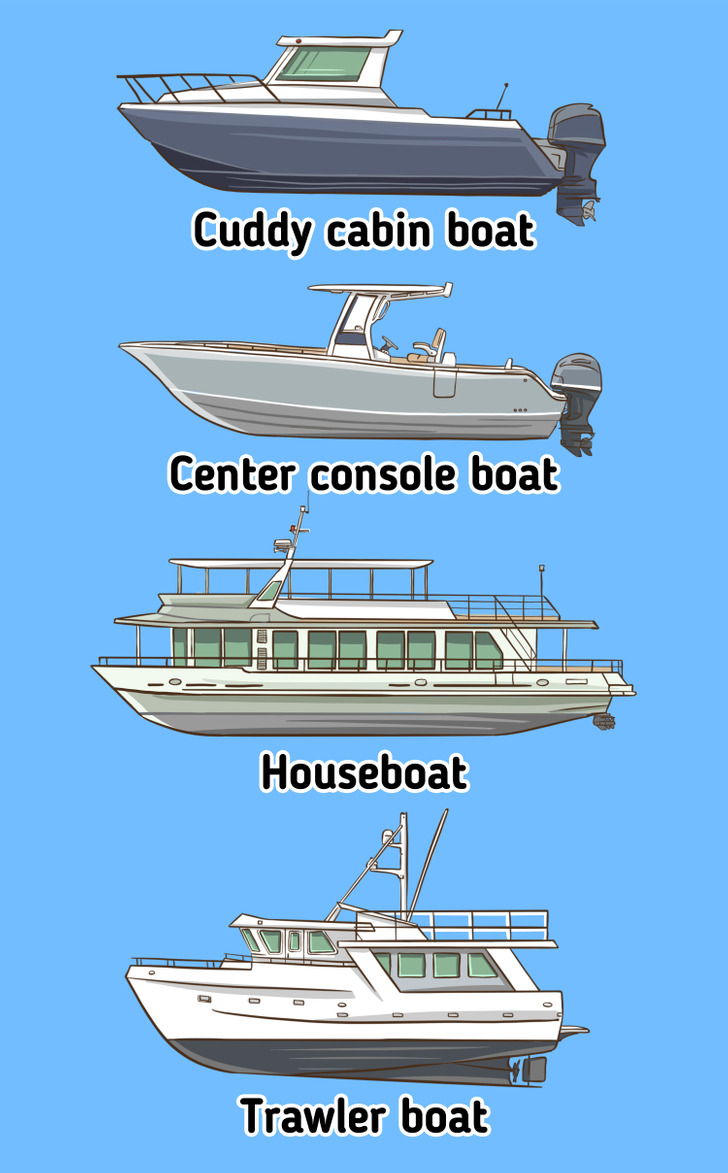
- Cuddy cabin boats are another type of family-friendly vessel well-suited for sailing, yachting, and fishing. This boat possesses a secret cabin within a closed deck space, has good maneuverability, and provides very good control while cruising.
- A center console boat has no cabin or foredeck, and the helm station is in the center of the boat. These boats are ideal for people who like fishing but who are also willing to try a hand in different boating activities. They are fast so they can perform well in racing and other competitive water sports.
- Houseboats are used for fun activities, like cruising and family sailing. Many people choose houseboats as they offer the experience of luxury living on the water while providing entertainment, fine dining, and proper sleeping arrangements. They are usually large in size and not very fast but are a perfect place to spend a vacation.
- A trawler boat can smoothly maneuver through bodies of water without excessive fuel consumption. Trawlers are built with spacious rooms and designed for long-distance cruising.
3. Sailboats
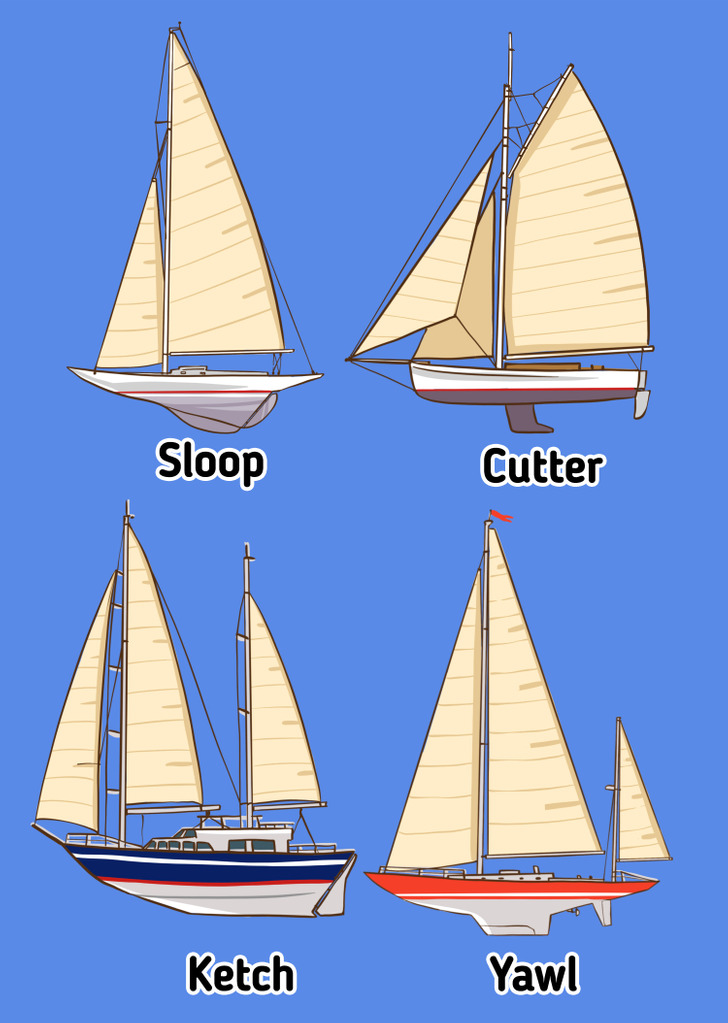
Sailboats can have 1 or 2 masts and are powered by the force of the wind.
These include:
- A sloop is a single-masted sailboat built with 2 sails — a foresail (headsail or jib) and a mainsail.
- A cutter is similar to the sloop but has an additional sail between the headsail and the mainsail. The mast is also set further back than in a sloop.
- A ketch is a sailboat with 2 masts. The main mast is built forward and the shorter mizzen mast is in the aft.
- A yawl is also a 1-masted sailboat, but unlike a ketch, it has a mizzen mast positioned aft of the rudder post.
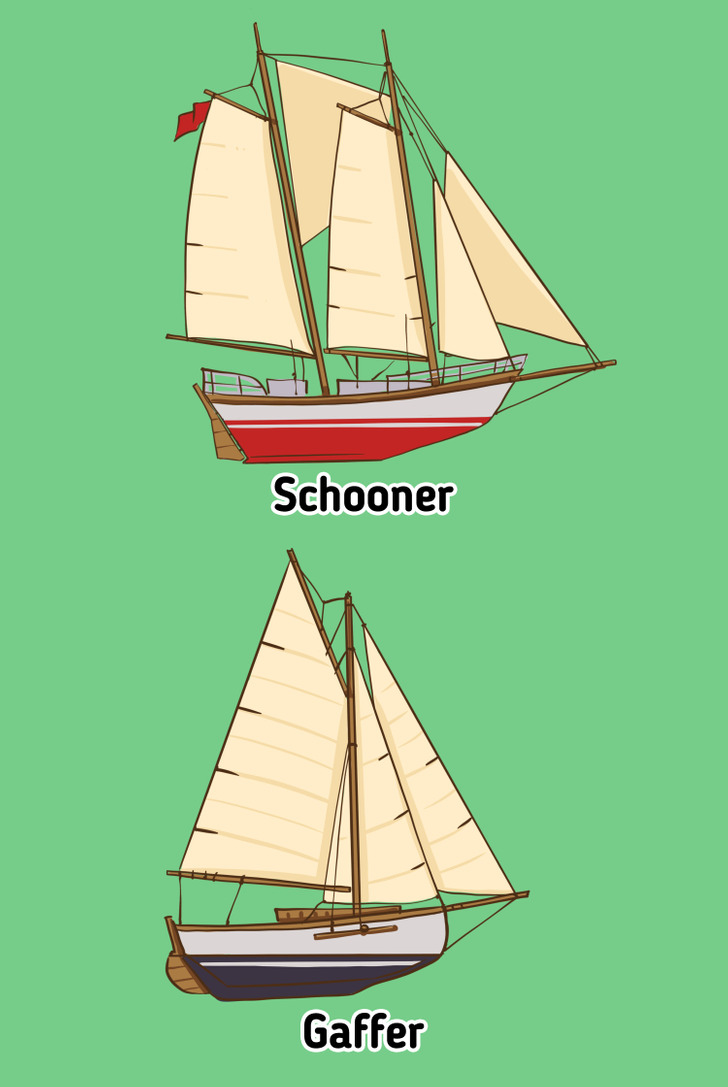
- The schooner is built with 2 or more masts and the mainmast is the same height or taller than the foremast.
- A gaffer, also referred to as gaffed-rigged, are sailboats that have a mainsail supported by a spar (or gaff). The gaff is hauled up the mast by a separate halyard.
Note: Yachts can be classified both as boats and ships, depending on their size. Many families like to engage in different water activities on this beautiful boat that can be custom-made and tailored for everyone’s needs.
Yachts can be either sailboats or motorboats depending on whether they have a built-in engine or they operate using a sail and the wind.
Bonus: historical boats and ships
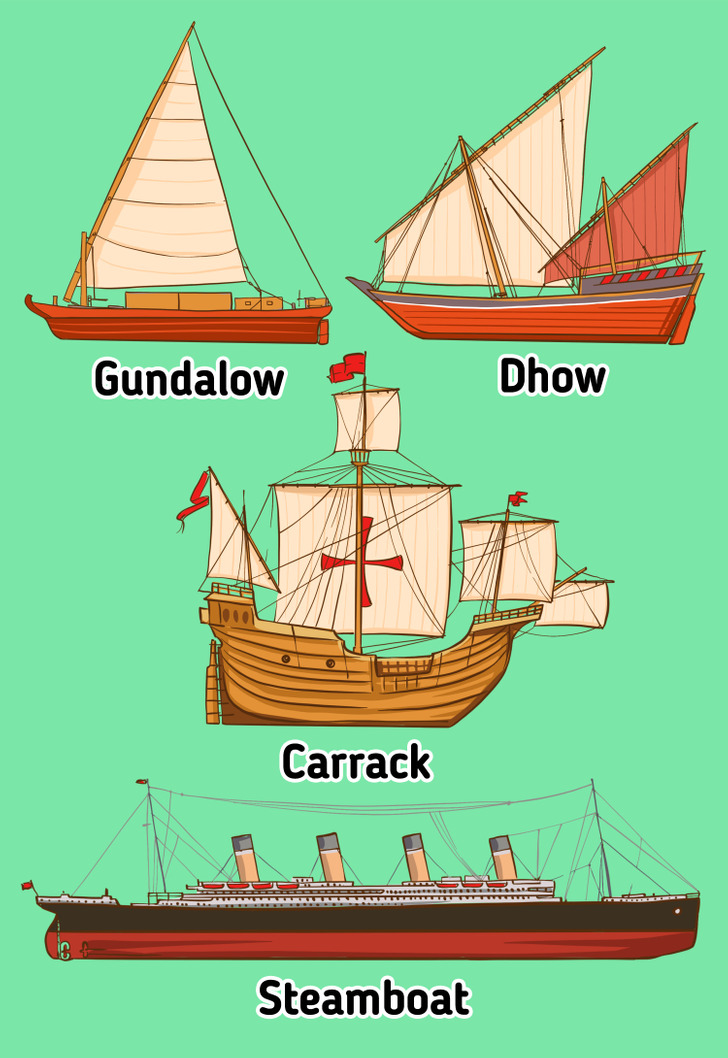
- A gundalow is a type of cargo barge, once common in the Gulf of Maine’s rivers and estuaries. It first appeared in the mid-1600s and moved crops, lumber, and granite. The gundalow was built with a flat bottom and operated with oars or paddles.
- The dhow is a traditional, 1 or 2-masted Arab sailing vessel used for trade and transportation in the Red Sea and the Indian Ocean.
- A carrack was a large ship used for exploration, transporting goods, and even as a warship during the fifteenth and sixteenth centuries. The most famous carracks are the Santa Maria of Christopher Columbus and the Victoria on which Ferdinand Magellan circumnavigated the globe from east to west.
- Steamboats (ships) were first introduced in the late 1700s and early 1800s. They were revolutionary in terms of river travel and trade, as they could travel faster (up to 5 miles per hour). One of the most famous steamboats was the Titanic that unfortunately sank in 1912.